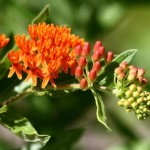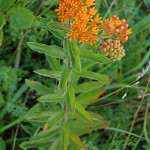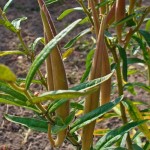Pleurisy Root – Asclepias tuberosa
|
Current Demand = GOOD |
Parts Used: Root |
 |
 |
 |
Family: Asclepiadaceae
Common Names: Butterfly weed, chigger weed, true butterfly, butterfly milkweed…
Description
This plant has robust stems with narrow leaves and terminal cymes of nectar-rich orange flowers. Unlike other milkweeds, which have white sap, this has clear or green juice.
The perennial plant grows up to 3 feet and the stems are covered with narrow leaves that are dark green. These leaves alternate along the stem. The brilliant orange or red flowers appear in midsummer and appear in clusters. These are followed by attractive green pods that open and release silky “parachutes” to drift away into the fall winds. The pods carry the seeds and they are about 5” long.
Planting
Growing region: These plants are found in the Eastern United States and through out the Midwest. Heavier populations can be found to the west in Texas, Oklahoma and Kansas, but it is common east of these regions. Pleurisy root is most often found along roadsides, fields and prairies as it prefers sand soil with more shade than sun.
Butterfly weed prefers full sun but can be in partial shade. The plant prefers a well drained light, rich sandy soil. This plant resents root disturbance and should be pot-grown from seed and planted in permanent positions as young plants. The seeds are best grown in a greenhouse as soon as it is ripe in the autumn or winter. The plants can then be placed in permanent positions in the spring.
Harvesting/Drying
Parts Used: root
For maximum potency Pleurisy root should be harvested in the late summer or fall after the growth has stopped and the seed pods have appeared. Only the plants roots have medicinal properties and market value. Gather the larger more mature plants leaving plenty of younger plants to seed the area for future harvest. The taproot has lateral stems and roots and is thick and knobby. It is white and fleshy and when dry it wrinkles.
After harvest, the roots should be washed in cold water and foreign material (rocks, dirt, other roots) must be removed. Unless your buyer is purchasing fresh dug roots (which they often do) the clean roots need to be dried. Large roots will need to be split in half to allow drying. Pleurisy root is difficult to dry without slicing into pieces. Pleurisy root can be dried in the sun although if possible dry indoors in a well ventilated barn loft or attic to protect from the elements. If natural heat is not available, you may need to add heat to a room and a fan for continuous airflow. The key to drying any root herb or bark is an even combination of heat and airflow. Never dry in an oven or microwave.
The roots will be completely dry (largest root will snap not bend), in approximately 5-10 days, depending on the size of the root and drying conditions. Place the dried roots carefully into a cardboard box or paper bag for storage in a dry area until you are ready to sell or use. Do not store in plastic or it will mold.
Attributes (Image)
By Ragesoss (Own work) [CC BY-SA 3.0 or GFDL], via Wikimedia Commons
By Photo by Derek Ramsey (Ram-Man) (Own work) [GFDL 1.2 or CC BY-SA 2.5], via Wikimedia Commons
By H. Zell (Own work) [GFDL or CC BY-SA 3.0], via Wikimedia Commons
 Root Buyer
Root Buyer